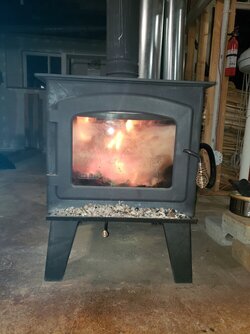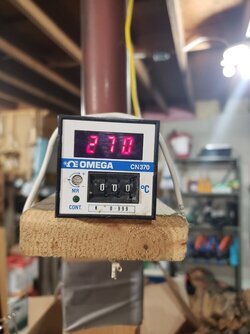What is the condensing temp for Creo?
- Thread starter kcmclellan
- Start date
-
Active since 1995, Hearth.com is THE place on the internet for free information and advice about wood stoves, pellet stoves and other energy saving equipment.
We strive to provide opinions, articles, discussions and history related to Hearth Products and in a more general sense, energy issues.
We promote the EFFICIENT, RESPONSIBLE, CLEAN and SAFE use of all fuels, whether renewable or fossil.
You are using an out of date browser. It may not display this or other websites correctly.
You should upgrade or use an alternative browser.
You should upgrade or use an alternative browser.
212 degrees at the top of the chimney. So it really depends upon your chimney height and insulationIs 510 degrees F inside a double wall flue 4 feet above stovetop to cool? What's the lowest you can go before you get a weak smoldering smoky fire?
Thank you in advance.
Internal flue & chimney until exiting out the roof. Total height around 26 feet, give or take a foot. I have to use the key damper sometimes, like tonight, when it tried to sneak away to infinity and beyond..212 degrees at the top of the chimney. So it really depends upon your chimney height and insulation
What type and size of chimney?Internal flue & chimney until exiting out the roof. Total height around 26 feet, give or take a foot. I have to use the key damper sometimes, like tonight, when it tried to sneak away to infinity and beyond..
Well it's a 6" chimney, but I can't say as I know the specifics of the chimney proper. I'll see if I can find the invoice for it. It was installed new when I bought the stove, maybe in 2012 or 2013. If I recall, the thickness of it when I take the cap off for cleaning is a half inch anyway....What type and size of chimney?
Is it a prefab stainless chimneyWell it's a 6" chimney, but I can't say as I know the specifics of the chimney proper. I'll see if I can find the invoice for it. It was installed new when I bought the stove, maybe in 2012 or 2013. If I recall, the thickness of it when I take the cap off for cleaning is a half inch anyway....
ohlongarm
Minister of Fire
Seems hot to me, when my stovetop temp is running 600 to 700 degrees center of, the double wall 1 foot from the stovetop is generall at half what the stove is and decreases incrementally. this has always been the rule with my Blaze King < King. Other BK owners may have different experiences, no problems here whatsoever.Is 510 degrees F inside a double wall flue 4 feet above stovetop to cool? What's the lowest you can go before you get a weak smoldering smoky fire?
Thank you in advance.
They aren't running a blaze king. But regardless 510-520 could absolutely be to cool and causing creosote issues further up the chimney depending upon other factors.Seems hot to me, when my stovetop temp is running 600 to 700 degrees center of, the double wall 1 foot from the stovetop is generall at half what the stove is and decreases incrementally. this has always been the rule with my Blaze King < King. Other BK owners may have different experiences, no problems here whatsoever.
Not for a non-cat. It is not comparable. Parity between the stovepipe and the stovetop temp is often where we cruise.Seems hot to me, when my stovetop temp is running 600 to 700 degrees center of, the double wall 1 foot from the stovetop is generall at half what the stove is and decreases incrementally. this has always been the rule with my Blaze King < King. Other BK owners may have different experiences, no problems here whatsoever.
MR. GLO
Feeling the Heat
Curious to know what your temps are at 18 inch mark...why at 4ft mark?
But for a new epa stove and. Non cat.
I'd say your ok But your glass shows your wood might not be 100 percent ready...
I'm 30 minutes into a load at 2 foot mark internal temp 570 degrees and 650 stt.
But for a new epa stove and. Non cat.
I'd say your ok But your glass shows your wood might not be 100 percent ready...
I'm 30 minutes into a load at 2 foot mark internal temp 570 degrees and 650 stt.
Ashful
Minister of Fire
The reality is, as bholler already correctly stated, there's no way to answer this question based on a measurement taken a foot or two above the stove. Pipe length, insulation, outdoor temperature, construction around it, and burn rate will all cause the temperature drop over the length of the pipe to vary.
To avoid condensation you would need to stay above 212 at outlet, but it's also not necessarily critical that you achieve this. This is why burning DRY wood is key to putting less water and creo into the pipe, in the first place. My pipe probe temps hold right around 260F when cruising for a 12 hour burn, just 14 inches above the stove collar, so I can almost guarantee I'm seeing an exhaust temperature well below 212F at the top of my 30 foot pipe, yet deposition is light enough that I'm only getting a soup can or two of crap out of that pipe after more than 6 cords thru it per season.
I assume this is possible only because the cat is successfully reburning nearly all of what passes thru it, just as a non-cat would do at a higher burn rate. The point is, don't assume you must keep the exhaust gas above 212F at outlet, just aim to burn dry wood and keep that stove in reburn thru as much of the burn cycle as is possible.
To avoid condensation you would need to stay above 212 at outlet, but it's also not necessarily critical that you achieve this. This is why burning DRY wood is key to putting less water and creo into the pipe, in the first place. My pipe probe temps hold right around 260F when cruising for a 12 hour burn, just 14 inches above the stove collar, so I can almost guarantee I'm seeing an exhaust temperature well below 212F at the top of my 30 foot pipe, yet deposition is light enough that I'm only getting a soup can or two of crap out of that pipe after more than 6 cords thru it per season.
I assume this is possible only because the cat is successfully reburning nearly all of what passes thru it, just as a non-cat would do at a higher burn rate. The point is, don't assume you must keep the exhaust gas above 212F at outlet, just aim to burn dry wood and keep that stove in reburn thru as much of the burn cycle as is possible.
stoveliker
Minister of Fire
Given that a pound of dry (0 percent) wood going through perfect combustion creates about half a pound of water, I would suggest to keep the flue temp everywhere above the boiling point of water. I.e. the mentioned 212 F.
The burning of dry wood is of course needed, but wet wood contributes to the problem more in lowering combustion temperature, and thus creating incomplete combustion (smoke particles), than by the extra water you have to send up the chimney. E.g. 60 lbs of 20 pct wood creates (in perfect combustion) 30 lbs of water + 12 lbs of water from the 20 pct water contents. So 30 lbs goes up to 42 lbs. Not insignificantly more, but not game changingly different from 30 lbs either.
The burning of dry wood is of course needed, but wet wood contributes to the problem more in lowering combustion temperature, and thus creating incomplete combustion (smoke particles), than by the extra water you have to send up the chimney. E.g. 60 lbs of 20 pct wood creates (in perfect combustion) 30 lbs of water + 12 lbs of water from the 20 pct water contents. So 30 lbs goes up to 42 lbs. Not insignificantly more, but not game changingly different from 30 lbs either.
Last edited:
snobuilder
Feeling the Heat
That can be scary for sure.Internal flue & chimney until exiting out the roof. Total height around 26 feet, give or take a foot. I have to use the key damper sometimes, like tonight, when it tried to sneak away to infinity and beyond..
snobuilder
Feeling the Heat
So does an owner need probes all along the chimney or at the top or does an owner need to climb up on the roof and check the top of the chimney temp during a burn?They aren't running a blaze king. But regardless 510-520 could absolutely be to cool and causing creosote issues further up the chimney depending upon other factors.
No people need to monitor the buildup in their chimney untill they figure out what temps work for their system. I mean yes a probe at the top would be fantastic but it just isn't reasonable. And not needed after you figure out what your system needsSo does an owner need probes all along the chimney or at the top or does an owner need to climb up on the roof and check the top of the chimney temp during a burn?
snobuilder
Feeling the Heat
So many variables. The simple purchase of a magnetic stove pipe temp gage on my single wall pipe showed why I had monthly creosote build up from the stove to wall section.No people need to monitor the buildup in their chimney untill they figure out what temps work for their system. I mean yes a probe at the top would be fantastic but it just isn't reasonable. And not needed after you figure out what your system needs
Yes with single wall a magnetic thermometer is all you need. That's all I have. But if you need double wall pipe a probe is needed. They work pretty much the same just probe will read higher because it is reading internal.So many variables. The simple purchase of a magnetic stove pipe temp gage on my single wall pipe showed why I had monthly creosote build up from the stove to wall section.
And as a general rule you can just go by the ranges on the thermometer. But if your chimney isn't insulated well you will have to run a bit higher. If it's insulated well you can run a little cooler.
Similar threads
- Replies
- 18
- Views
- 2K
- Replies
- 8
- Views
- 752
- Replies
- 6
- Views
- 722
- Replies
- 5
- Views
- 980



